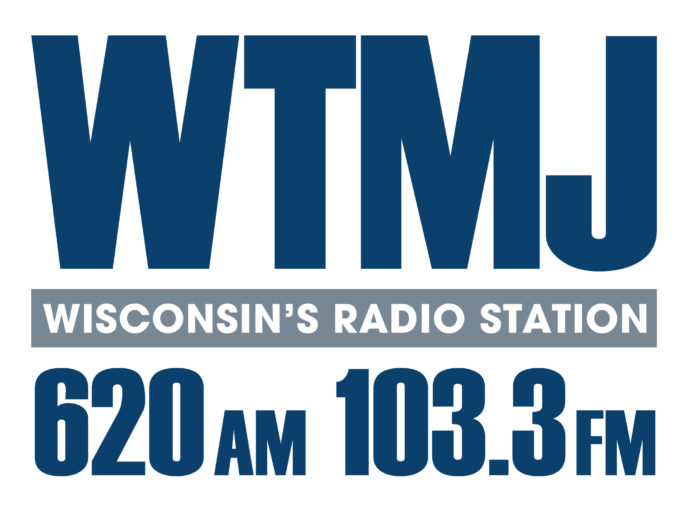RBR+TVBR INFOCUS
For the company that winds up purchasing The E.W. Scripps Co.‘s Milwaukee stations, there’s now an added incentive — and a boost to Scripps’ profit-minded dealmakers.
After some uncertainty following a July 2017 announcement that an FM translator was coming for a crown jewel in the Scripps stable, Class B News/Talk WTMJ-AM 620, an MHz boost for this heritage property has finally arrived.
Is “AM revitalization” Talk Radio’s FM future? Tom Langmyer, Scripps’ Milwaukee VP/GM and the VP/News and Talk for Scripps’ radio stations, spoke exclusively to RBR+TVBR on the topic.
Some seven months ago, Scripps revealed that WTMJ, a 50kw facility broadcasting from 4 towers during daylight hours and 10kw at night from 6 towers — is getting an FM translator to “expand the programming reach” for the station.
The translator is W277CV, at 103.3 MHz. The facility moved from Waukegan, Ill., to the heart of Milwaukee, giving it coverage of nearly all of the metropolitan area. It is using a tower on Humboldt Blvd. along the Milwaukee River, just north of E. Capitol Drive. The 250-watt signal covers Milwaukee and its adjacent suburbs.
Friday (2/23) is the first day FM listeners, and users of the NextRadio App on Android-powered devices, can access WTMJ without going to the AM band or to Country WKTI-FM 94.5’s HD2 signal.
“For 90 years Milwaukee has depended upon WTMJ for news, local talk and sports,” Langmyer said in prepared comments, “It’s important to make our content easy to find, and we’re excited to add an additional platform at 103.3 FM along with our digital distribution platforms.”
WTMJ is the flagship radio station of Wisconsin’s three pro sports teams, the NFL’s Green Bay Packers, the NBA’s Milwaukee Bucks, and Major League Baseball’s Milwaukee Brewers.
While the debut of “WTMJ-FM” has been in the works for months, getting it operational came in to question just days after Scripps announced the move was happening.
Scripps was a side player in the matter, which involved the owner of the translator, Frank McCoy and Michael Crute, owner of Class D News/Talk WRRD-AM 1510 in Milwaukee, which uses Waukesha as its city of license. Crute claimed that McCoy could not move the W277CV tower from Waukegan, Ill., to Milwaukee, for WTMJ. Rather, it could only be used for WRRD for a four-year period, Crute argued in a formal objection filed with the FCC.
Other claims were offered by Crute, including a statement that Scripps offered a sweetheart deal including assumption of tower construction expenses, while also suggesting that Scripps was using its corporate might to squelch a progressive talk operation.
WRRD’s moniker is “Resistance Radio,” with local host Earl Ingram in the 7-9am slot and syndicated hosts Thom Hartmann and Stephanie Miller also on the lineup. The station’s website opening solicits for listener donations.
Scripps’ arrangement has always been with McCoy. In the end, Crute and WRRD will now need to seek another source for its FM revitalization.
AM REVITALIZATION: TALK RADIO’S FM FUTURE?
The term “AM revitalization” is, in a way, a misnomer. There have been no improvements to the kHz-based facilities seen across the U.S. since the introduction of AM revitalization, a plan designed to throw a new and important lifeline to stations with a distinct disadvantage to many competitors: They’re not on FM radio.
Thanks to the introduction of FM translators, AM radio stations can now reach a whole new set of potential listeners. The biggest boost from AM revitalization efforts has arguably been seen with News/Talk radio stations, some of which are owned by the biggest radio broadcasting companies.
Interestingly, translators are only part of the story. Fully licensed stations in some markets serve as simulcast partners for the big-signal heritage AM. Either way, there’s a revitalization being seen for News/Talk, and it could preserve the format’s long-term health.
One format veteran currently seeking some revitalization for one of the nation’s more storied News/Talk outlets is Langmyer. Some may ask why.
WTMJ’s signal stretches from Champaign, Ill., to Marquette, Mich., and at night can be heard across the Eastern seaboard. In 1977 that would have been heavenly. In 2017, it doesn’t matter as much as getting on FM – a band accessible and wholly familiar with the entire listening audience.
With the addition of an FM signal for a Talk station, there’s certainly an opportunity to welcome listeners that “never go to AM.” Does this involve a tweak in programming, or simply plopping the AM on FM and that’s that?
“Every operator will want to make sure it’s done the right way,” Langmyer told RBR+TVBR in August 2017, for our Fall 2018 Radio Show Special Edition. “With the addition of an FM signal, once you introduce yourself, do you want to make a product adjustment? Yes. The stations that have been most successful when adding an FM signal, or making the move entirely to FM, have made very noticeable strategic changes to their talk product. While growth is fueled by an expanded available audience, it’s also a huge demographic growth opportunity.”
For a News/Talker gaining an FM signal, the essence and feel of the station may change.
That’s fine so long as there’s no wholesale format change. “Members of Generation X, for example, are very large users of radio and FM, in particular, but have been underserved by news and talk formats on radio,” Langmyer notes.
A BOOST, NOT A REPLACEMENT
Talk stations are not alone with “AM revitalization.” What does it mean for AMs with other formats?
“All formats apply,” Langmyer says. “At this time, most successful AM stations are doing some form of talk, whether it’s News, News/Talk, pure talk or sports. FM is a big lake, and the bigger the lake, the more places there are to fish. ‘Revitalization’ is a way to get AM stations on FM, and that’s a great thing. But make no mistake, revitalizing our business also comes from building a multi-media experience through digital platforms, prominence in-dash and strong products that speak to today’s generation.”
It’s a way to get AM stations on FM …
Does this point to mounting evidence that AM radio could be entering its final stage?
With NextRadio unable to get AM, and even older version of the iHome clock radio absent of an AM radio tuner, could the next decade see the sign-off of AM radio stations across the country that could have shifted to an HD Radio multicast years ago?
“AM radio remains strong in many cases,” Langmyer says. “Look at some markets and see how much cume is still on AM. Many of the nation’s top revenue producers are AM stations. Still, the amount of FM exclusive cume is significant. So, to your point, being on all the right platforms is key.”
At the same time, audio products shouldn’t just be defined by an address on a band, he believes. “Revitalization must come in even more ways than giving an AM daytimer a spot on the FM band. Globally, it’s also about product evolution for today’s consumer.”
Is AM revitalization not so urgent in some markets, compared to others?
Langmyer was asked this question with the knowledge that he began his career in Buffalo, where WECK-AM is being reborn as a Full Service radio station with heritage air personalities, CBS News Radio … and an FM translator.
“Great AM stations remain so because of great content,” Langmyer says. “There are still great AM markets for a number of reasons including heritage, history, topography, commute times, ‘generational passage’ within families, and market connection. In the end, it’s about exceptional content.”
Langmyer has been associated with some legendary call letters, such as KMOX in St. Louis and WGN in Chicago. He’s also worked with many other major-market AM stations, many of which are now owned by Entercom as a result of its CBS Radio merger. Will these stations eventually need “revitalization”?
“These AM stations are excellent,” Langmyer says. “Yet, these companies and others with news, sports and talk-based formats have seen greater success when an FM signal is added.”
That said, there is a responsibility for radio broadcasting companies that comes with adding an FM signal for an AM station: Don’t cannibalize the AM.
“We have to be very careful to make sure that big and historically successful AM stations aren’t victimized by their own success,” Langmyer says. “They’ve achieved their earned leadership positions through stellar service to their communities. However, the ‘revitalization’ process puts them at the back of the line, sometimes in favor of stations that are just ‘a signal,’ having provided little service for many years.
“Revitalization is about keeping our brands vital and having universal access to our audiences in order to best serve them,” Langmyer concludes. “For AMs, a big part of that access means the addition of FM presence.”
Langmyer was interviewed for the 2018 Radio Show Special Edition, distributed in Austin to all conference attendees.
RBR+TVBR Members receive a special PDF version of our Spring and Fall print editions. The RBR+TVBR 2018 NAB Show Special Edition is scheduled for distribution in Las Vegas on April 8. For more information on advertising opportunities, please contact your RBR+TVBR representative or call 703-490-3099.





